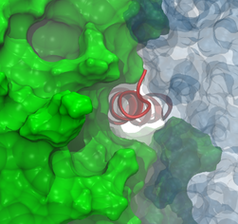Highlights of our Work
2024 | 2023 | 2022 | 2021 | 2020 | 2019 | 2018 | 2017 | 2016 | 2015 | 2014 | 2013 | 2012 | 2011 | 2010 | 2009 | 2008 | 2007 | 2006 | 2005 | 2004 | 2003 | 2002 | 2001

image size:
223.2KB
made with VMD
For newly made membrane proteins, getting to their final destination in
the membrane requires another protein, the channel SecY, to provide a
pathway (see the Sept. 2007 and Feb. 2011 highlights). But just knowing
the route is not enough, because SecY presents the nascent protein with a choice:
insert into the membrane or cross the channel to the watery exterior.
How the nascent protein comes to a decision has long been a point of
uncertainty, although it has been presumed to be driven by purely energetic
considerations, i.e., the protein goes to the environment it ultimately prefers.
Now, recent simulations and free-energy calculations spanning time scales from
nanoseconds all the way to seconds have revealed that how long the nascent
protein deliberates in the channel is just as great a factor in its final
location as how favorable it is there. It was found that the longer the protein
takes to decide, the more likely it is to choose the membrane, proving that,
at least for membrane insertion, slow and steady wins out. More information
can be found on the protein translocation
website.



